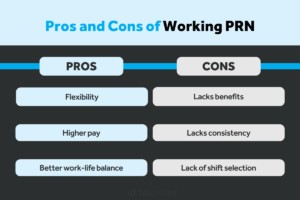Are you curious about PRN work and how it can fit into your life? At WHAT.EDU.VN, we provide clear and concise answers to your questions, including what PRN work is, its benefits, and potential drawbacks, covering everything from PRN meaning to flexible employment options. This guide will help you understand the world of “as needed” employment and see if it’s right for you.
1. What Does PRN Work Mean?
PRN work, derived from the Latin phrase “pro re nata” meaning “as needed,” refers to employment where you work on a flexible, on-demand basis. In the medical field, this means healthcare professionals, like nurses, are called in to work when needed, filling in gaps in the regular staffing schedule. This arrangement offers both freedom and unique challenges.
1.1 Understanding PRN in Various Sectors
While PRN is commonly associated with healthcare, it can also exist in other industries. For instance, a PRN consultant might be brought in for specific projects, or a PRN teacher could fill in for absent full-time staff. Understanding the core concept of “as needed” helps to clarify its use across sectors.
1.2 PRN in the Medical Field: A Closer Look
In medical settings, PRN staff, including nurses and therapists, provide essential support during peak times, staff shortages, or special events. This flexibility ensures that healthcare facilities can maintain adequate staffing levels without the overhead of full-time employees.
2. What Are the Key Characteristics of PRN Jobs?
PRN jobs are defined by several unique characteristics that set them apart from traditional employment. These include flexibility, variable hours, and the absence of typical employee benefits.
2.1 Flexibility and Variable Hours
One of the biggest draws of PRN work is its flexibility. Employees can often set their own schedules, choosing when and where they want to work. This arrangement is ideal for individuals seeking a better work-life balance or those with other commitments.
2.2 No Guaranteed Hours
While flexibility is a plus, it also means that PRN employees don’t have guaranteed hours. Work availability depends on the employer’s needs, which can fluctuate. This variability requires careful financial planning and adaptability.
2.3 Absence of Traditional Benefits
PRN positions typically don’t include benefits such as health insurance, paid time off, or retirement plans. The higher hourly pay often compensates for this, but it’s important to factor in these costs when evaluating the overall compensation package.
3. What Are Examples of PRN Positions?
PRN positions span various industries, each with its own specific roles and responsibilities. Here are some common examples:
3.1 PRN Nurse
A PRN nurse fills in where needed in a healthcare facility. This could involve covering shifts for nurses on leave, providing extra support during busy periods, or filling in for unexpected absences.
3.2 PRN Therapist
PRN therapists, such as physical therapists or occupational therapists, offer their services on an as-needed basis. They may work with multiple facilities or clients, providing specialized care when and where it’s required.
3.3 PRN Consultant
In the business world, PRN consultants bring their expertise to projects or companies on a temporary basis. Their work can range from providing strategic advice to implementing specific solutions.
3.4 PRN Teacher
PRN teachers fill in for regular teachers who are absent due to illness, training, or other reasons. They ensure continuity in education, often working on short-term assignments.
Alt text: An African-American male nurse in scrubs smiles, representing the flexibility and opportunities in PRN medical work.
4. What Are the Benefits of PRN Work?
PRN work offers numerous advantages, particularly for those who value flexibility and control over their schedules.
4.1 Flexibility
The ability to set your own hours is a major perk of PRN work. This flexibility allows you to balance work with personal commitments, such as family, education, or other jobs.
4.2 Higher Pay Rates
PRN employees often earn higher hourly rates compared to their full-time counterparts. This premium pay compensates for the lack of benefits and the unpredictability of work availability.
4.3 Variety of Work Environments
Working PRN can expose you to a variety of work environments and experiences. This can broaden your skill set and make you more adaptable in your field.
4.4 Career Advancement Opportunities
PRN positions can sometimes lead to full-time employment. By demonstrating your skills and reliability, you can increase your chances of being offered a permanent role.
4.5 Work-Life Balance
PRN work provides the potential for a healthier work-life balance. By controlling when and how much you work, you can prioritize your personal well-being and other interests.
5. What Are the Drawbacks of PRN Work?
Despite its advantages, PRN work also comes with potential drawbacks that need to be considered.
5.1 Lack of Benefits
The absence of benefits, such as health insurance and paid time off, is a significant disadvantage. PRN workers must often cover these costs themselves, which can impact their overall financial stability.
5.2 Income Instability
The lack of guaranteed hours can lead to income instability. PRN workers may experience periods of high demand followed by lulls, making budgeting and financial planning challenging.
5.3 Limited Job Security
PRN positions typically offer less job security compared to full-time roles. Contracts can be terminated with little notice, and work availability can fluctuate based on the employer’s needs.
5.4 Potential for Isolation
PRN workers may feel isolated due to the lack of consistent interaction with colleagues. Building strong professional relationships can be more difficult when you’re not part of a permanent team.
5.5 Administrative Burdens
PRN workers often handle administrative tasks, such as tracking hours and managing invoices, which can be time-consuming.
6. How Does PRN Work Differ From Other Employment Types?
Understanding how PRN work differs from other employment types can help you determine if it’s the right fit for you.
6.1 PRN vs. Full-Time Employment
Full-time employment offers guaranteed hours, benefits, and job security, but it may lack the flexibility of PRN work. Full-time employees typically work a set schedule and are part of a permanent team.
6.2 PRN vs. Part-Time Employment
Part-time employment provides a middle ground, offering some benefits and a more predictable schedule than PRN work. However, part-time employees usually have less flexibility and lower pay rates compared to PRN workers.
6.3 PRN vs. Contract Work
Contract work involves a specific project or period with defined terms. While contract workers may have more flexibility than full-time employees, they typically don’t have the same level of control over their schedule as PRN workers.
6.4 PRN vs. Per Diem
Per diem and PRN are often used interchangeably, but there can be subtle differences. Per diem (Latin for “per day”) typically refers to short-term assignments, while PRN may involve a more ongoing relationship with an employer.
7. Who Is PRN Work Suitable For?
PRN work can be an excellent option for certain individuals, depending on their circumstances and preferences.
7.1 Students
Students can benefit from the flexibility of PRN work, allowing them to balance their studies with part-time employment.
7.2 Parents
Parents who need flexible schedules to accommodate childcare responsibilities may find PRN work appealing.
7.3 Semi-Retirees
Individuals transitioning into retirement can use PRN work to stay active and engaged in their field while reducing their work hours.
7.4 Freelancers
Freelancers can supplement their income with PRN work, providing a more stable financial base.
7.5 Those Seeking Variety
PRN work can be ideal for those who enjoy variety and new challenges, as it offers exposure to different environments and projects.
8. How to Find PRN Work?
Finding PRN work involves networking, online job boards, and specialized staffing agencies.
8.1 Networking
Networking with colleagues and industry contacts can lead to PRN opportunities.
8.2 Online Job Boards
Websites like Indeed, LinkedIn, and specialized healthcare job boards list PRN positions.
8.3 Staffing Agencies
Staffing agencies specializing in temporary or PRN placements can connect you with employers in need of flexible workers.
8.4 Hospital and Healthcare Websites
Check the career pages of local hospitals and healthcare facilities for PRN job postings.
9. How to Succeed in PRN Work?
Succeeding in PRN work requires adaptability, professionalism, and strong communication skills.
9.1 Adaptability
Be ready to adjust to various work settings and responsibilities.
9.2 Professionalism
Maintain a high level of professionalism in all interactions and assignments.
9.3 Communication Skills
Keep clear lines of communication with employers and colleagues.
9.4 Time Management
Efficiently manage your time to meet deadlines and handle administrative tasks.
9.5 Financial Planning
Budget carefully and plan for periods of low work availability.
10. What Is the Impact of PRN Work on the Healthcare Industry?
PRN work plays a crucial role in maintaining adequate staffing levels and ensuring quality care in the healthcare industry.
10.1 Addressing Staffing Shortages
PRN staff fill in gaps created by staff shortages, preventing burnout and maintaining patient care standards.
10.2 Cost-Effectiveness
Hiring PRN staff can be more cost-effective for healthcare facilities than hiring full-time employees, especially during peak periods.
10.3 Flexibility for Healthcare Workers
PRN work allows healthcare workers to balance their careers with personal needs, improving job satisfaction and reducing turnover.
10.4 Maintaining Quality of Care
PRN staff bring diverse skills and experience to healthcare facilities, enhancing the overall quality of care.
11. What Are the Legal and Ethical Considerations of PRN Work?
PRN work raises certain legal and ethical considerations that both employers and employees should be aware of.
11.1 Fair Labor Standards
Employers must comply with fair labor standards, including minimum wage and overtime pay for PRN workers.
11.2 Worker Classification
Properly classifying PRN workers as employees or independent contractors is essential to avoid legal issues.
11.3 Patient Safety
Healthcare facilities must ensure that PRN staff are adequately trained and competent to provide safe patient care.
11.4 Ethical Treatment
Treating PRN workers with respect and fairness is crucial for maintaining morale and ensuring quality service.
12. What is the Future of PRN Work?
The future of PRN work looks promising, with increasing demand for flexible employment options across various industries.
12.1 Growing Demand
The gig economy and the increasing desire for work-life balance are driving the demand for PRN work.
12.2 Technological Advancements
Online platforms and mobile apps are making it easier to connect PRN workers with employers.
12.3 Industry Expansion
PRN work is expanding beyond healthcare into other sectors, such as education, business, and technology.
12.4 Policy Changes
Changes in labor laws and regulations may impact the future of PRN work, requiring both employers and employees to stay informed.
13. What Are Some Alternatives to PRN Work?
If PRN work isn’t quite the right fit, there are alternative employment options to consider.
13.1 Part-Time Employment
Part-time employment offers a balance between flexibility and stability, with some benefits and a more predictable schedule.
13.2 Contract Work
Contract work provides specific project-based assignments with defined terms and pay rates.
13.3 Freelancing
Freelancing allows you to work independently on various projects, setting your own rates and schedule.
13.4 Remote Work
Remote work enables you to work from home or other locations, providing flexibility and autonomy.
Alt text: A graphic outlining the benefits and drawbacks of PRN nursing, highlighting flexibility and potential challenges.
14. What Questions Should You Ask Before Taking a PRN Position?
Before accepting a PRN position, it’s important to ask the right questions to ensure it aligns with your needs and goals.
14.1 What Is the Pay Rate?
Understand the hourly rate and any potential overtime pay.
14.2 Are There Shift Minimums or Maximums?
Clarify any requirements for the number of shifts you must work.
14.3 How Far in Advance Is the Schedule Made?
Find out how much notice you’ll receive for available shifts.
14.4 What Is the Cancellation Policy?
Learn the consequences of canceling a shift and how much notice you need to give.
14.5 Is There Opportunity for Full-Time Employment?
Inquire about the possibility of transitioning to a full-time role in the future.
15. How to Negotiate a PRN Work Agreement?
Negotiating a PRN work agreement can help you secure favorable terms and conditions.
15.1 Research Industry Standards
Know the typical pay rates and expectations for PRN positions in your field.
15.2 Highlight Your Value
Emphasize your skills, experience, and reliability.
15.3 Be Clear About Your Needs
Communicate your scheduling preferences and any other requirements.
15.4 Be Willing to Compromise
Be open to negotiation and finding solutions that work for both parties.
15.5 Get It in Writing
Ensure all terms and conditions are documented in a written agreement.
16. What Resources Are Available for PRN Workers?
Several resources are available to support PRN workers in their careers.
16.1 Professional Associations
Join professional associations related to your field for networking and resources.
16.2 Online Communities
Participate in online forums and communities for PRN workers to share advice and experiences.
16.3 Financial Planning Services
Seek guidance from financial planners to manage income variability and plan for the future.
16.4 Career Counseling
Consult with career counselors to explore opportunities and develop your skills.
16.5 Legal Assistance
Access legal assistance to understand your rights and responsibilities as a PRN worker.
17. How to Manage Finances as a PRN Worker?
Managing finances as a PRN worker requires careful budgeting and planning.
17.1 Create a Budget
Track your income and expenses to create a realistic budget.
17.2 Save for Taxes
Set aside a portion of your income for taxes, as you may be responsible for self-employment taxes.
17.3 Build an Emergency Fund
Establish an emergency fund to cover unexpected expenses or periods of low work availability.
17.4 Invest Wisely
Consider investing in retirement accounts or other investment vehicles to secure your financial future.
17.5 Seek Financial Advice
Consult with a financial advisor to develop a personalized financial plan.
18. How to Balance PRN Work With Personal Life?
Balancing PRN work with personal life requires setting boundaries and prioritizing self-care.
18.1 Set Boundaries
Establish clear boundaries between work and personal time.
18.2 Prioritize Self-Care
Make time for activities that promote your physical and mental well-being.
18.3 Communicate With Family
Keep your family informed about your work schedule and any changes.
18.4 Plan Ahead
Plan your schedule in advance to avoid conflicts and ensure you have time for personal commitments.
18.5 Seek Support
Lean on friends, family, or support groups for help and encouragement.
19. What Are Some Common Myths About PRN Work?
Several myths surround PRN work that can deter people from considering it as a viable employment option.
19.1 Myth: PRN Work Is Only for Healthcare Professionals
Fact: PRN work exists in various industries beyond healthcare.
19.2 Myth: PRN Workers Don’t Make Good Money
Fact: PRN workers often earn higher hourly rates than full-time employees.
19.3 Myth: PRN Work Is Unstable and Unreliable
Fact: PRN work can provide flexibility and income opportunities, but requires careful planning.
19.4 Myth: PRN Workers Are Always Last to Get Shifts
Fact: Shift availability varies depending on the employer and the worker’s skills and experience.
19.5 Myth: PRN Workers Don’t Have Opportunities for Advancement
Fact: PRN work can lead to full-time employment and career advancement.
20. What Are Some Inspiring Stories of People Succeeding in PRN Work?
Numerous individuals have found success and fulfillment in PRN work.
20.1 Story 1: The Student Balancing Studies and Career
A college student uses PRN work to fund their education and gain valuable experience in their field.
20.2 Story 2: The Parent Finding Work-Life Balance
A parent utilizes PRN work to balance their career with childcare responsibilities.
20.3 Story 3: The Semi-Retiree Staying Active and Engaged
A semi-retiree uses PRN work to stay active in their profession while reducing their work hours.
20.4 Story 4: The Freelancer Supplementing Their Income
A freelancer relies on PRN work to provide a stable financial base while pursuing their passion projects.
FAQ: Understanding PRN Work
| Question | Answer |
|---|---|
| What does PRN stand for in medical terms? | PRN stands for “pro re nata,” a Latin phrase meaning “as needed.” |
| Is PRN work the same as per diem? | While often used interchangeably, per diem typically refers to short-term assignments, while PRN may involve a more ongoing relationship. |
| What are the benefits of PRN nursing? | Flexibility, higher pay rates, and a variety of work environments are key benefits. |
| What are the drawbacks of PRN work? | Lack of benefits, income instability, and limited job security are potential drawbacks. |
| How do I find PRN jobs near me? | Check online job boards, staffing agencies, and the career pages of local hospitals and healthcare facilities. |
| Who is PRN work suitable for? | Students, parents, semi-retirees, and those seeking variety may find PRN work appealing. |
| What questions should I ask before accepting a PRN position? | Pay rate, shift minimums, scheduling policies, and cancellation policies are important to clarify. |
| How can I manage my finances as a PRN worker? | Create a budget, save for taxes, build an emergency fund, and seek financial advice. |
| What resources are available for PRN workers? | Professional associations, online communities, financial planning services, and career counseling can provide support. |
| What is the future of PRN work? | The demand for flexible employment options is growing, making the future of PRN work promising. |


Understanding “What Is Prn Work” can open doors to a more flexible and fulfilling career. Whether you’re seeking better work-life balance, higher pay, or diverse experiences, PRN work offers unique opportunities to achieve your goals.
Ready to explore the world of flexible employment and find answers to all your career questions? Visit WHAT.EDU.VN today. Our platform provides a free and easy way to get expert advice and connect with a community of knowledgeable professionals. Don’t hesitate—ask your question now and unlock the potential of PRN work with WHAT.EDU.VN!
Contact Us:
Address: 888 Question City Plaza, Seattle, WA 98101, United States
WhatsApp: +1 (206) 555-7890
Website: what.edu.vn
